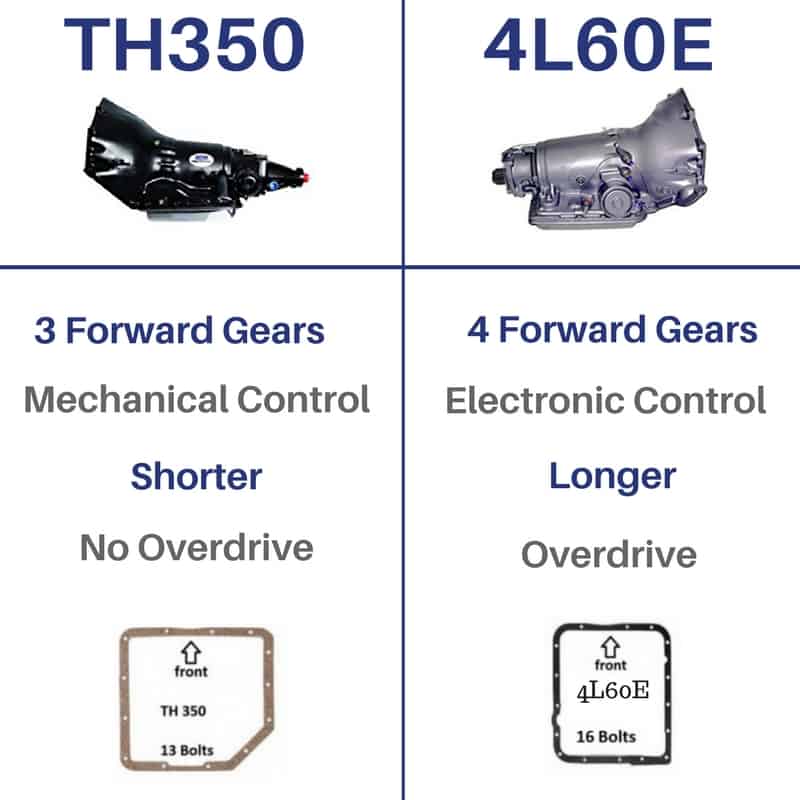The TH350 was GM’s go to transmission for light duty vehicles for at least 20 years. Beginning in the early nineties, the 4L60E began to be the go to transmission for GM light duty cars and trucks. When comparing the TH350 vs the 4L60E, there are many differences.
GM made the 4L60/700R4 before the 4L60E. The 4L60 is essentially the same transmission on the outside as the early 4L60E. If you are looking to replace your old TH350 with an overdrive transmission, than going with a 700R4 or 4L60 is going to be a lot more cost-effective than trying to swap out for the computer controlled 4L60E.
Related: 4L60 vs. 4L60E
4L60E vs TH350: Biggest differences
There are many differences between these transmissions, and we’ll get into them more below, but the largest ones have to do with making them work in a computer controlled (TH350) or non computer controlled car (4L60E). The two biggest obstacles when putting a TH350 in a vehicle that originally came with a 4L60E (and vice versa) are:
- Shift control– The TH350 is controlled by engine vacuum and a kick down cable. The 4L60E on the other hand is controlled by the engines computer. So if you put a 4L60E behind an old small-block Chevy it’ll only run in second or third gear without the computer control. It is a bit easier to run a TH350 behind an LS series engine. You’ll still need a custom kick down bracket and a way to hook into the vacuum port on the engine.
- Engaging the Torque Converter– The TH350 and 4L60E both need an adapter to correctly engage the flywheel if the TH350 is going to run behind an LS motor, or if the 4L60E is going to run behind a classic motor it’ll need an adapter too.
More info on this can be found not the LS Swap Transmission guide.
There are many other differences between the two transmissions that are noteworthy as well. This is a broad take on these differences.
- Overdrive– If how they are controlled is of no concern to you, it still may be worth noting the TH350 has no overdrive gear like the 4L60E, which means that an engine with the TH350 is going to run down the highway at a lot higher of an RPM than the 4L60E. The TH350 has three forward gears and the 4L60E has four.
- Locking Torque Converter– The 4L60E has a locking torque converter, which means that a clutch will engage at a high enough speed and allow for a true direct connection between the engine and transmission. This increases fuel economy and slightly lowers RPM going down the road. You have to set up wiring to make it work in a car that it was never equipped with.
- Length– The TH350 is a shorter transmission, so if you were going to swap one for the other, you’d need to have your driveshaft resized or replaced.
- Bellhousing Bolt Pattern– The TH350 has a bolt at the 12 o’clock position that most Gen III 4L60E transmissions just do not have. It’s not an issue to bolt one where the other was. Just use whatever bolts line up properly.
- Case– The TH350 uses a two piece case ( body, tail shaft), and the 4L60E has used a three-piece (bellhousing, body, tail shaft) and a two piece design. A two piece design is always an earlier 4L60E and was probably bolted behind an SBC originally. For more on the differences in the 4L60E over the years and how to ID one please visit the 4L60E identification page.
- VSS/Speedometer– The TH350 uses a speedometer gear to turn the speedometer, while the 4L60E uses a Vehicle Speed Sensor to relay speed data to the vehicles computer, which in turn tells the speedometer how fast the vehicle is moving.
There are many differences between these two transmissions. This should give you a basic idea of what would be involved in swapping one for the other, as well as what the major differences between the TH350 vs 4L60E are. Good luck!

